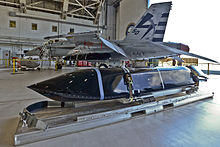Long Range Anti-Ship Missile
| AGM-158C LRASM | |
|---|---|

A Long Range Anti-Ship Missile (LRASM) mass simulator integrated on F/A-18E Super Hornet at NAS Patuxent River in 2015.
|
|
| Type | Anti-ship cruise missile |
| Place of origin | United States |
| Service history | |
| In service | U.S. Air Force: 2018 U.S. Navy: 2019 |
| Used by |
U.S. Navy U.S. Air Force |
| Production history | |
| Manufacturer | Lockheed Martin |
| Unit cost | $700,000-$1 million |
| Specifications | |
| Warhead | 1,000 lb (450 kg) blast-fragmentation penetrator |
|
|
|
| Speed | High-subsonic |
|
Launch
platform |
F/A-18E/F Super Hornet B-1B Lancer Mark 41 Vertical Launch System F-35 Lightning II |
The AGM-158C LRASM (Long Range Anti-Ship Missile) is a stealthy anti-ship cruise missile under development for the United States Navy by the Defense Advanced Research Projects Agency (DARPA). The LRASM was intended to pioneer more sophisticated autonomous targeting capabilities than the US Navy's current Harpoon anti-ship missile, which has been in service since 1977.
The Navy was authorized by the Pentagon to put the LRASM into limited production as an operational weapon in February 2014 as an urgent capability stop-gap solution to address range and survivability problems with the Harpoon and to prioritize defeating enemy warships, which has been neglected since the end of the Cold War but taken on importance with the modernization of the Chinese People’s Liberation Army Navy. The Navy will hold a competition for the Offensive Anti-Surface Warfare (OASuW)/Increment 2 anti-ship missile as a follow-on to LRASM to enter service in 2024.
Competitors to Lockheed Martin protested the decision to award them a contract given the circumstances of selection and competition for the missile. The Navy responded by saying Lockheed's LRASM program was limited in scope, the decision to move ahead with them was made after an initial DARPA contract award, and that it was an urgent need to face future threats. The initial LRASMs are expected to be operational in 2018. The OASuW Increment 2 competition will be completely open and start by FY 2017. It is expected the LRASM will compete against the joint Kongsberg/Raytheon offering of the Joint Strike Missile (JSM) for air-launch needs and an upgraded Raytheon Tomahawk cruise missile for surface-launch needs.
In August 2015, the Navy officially designated the air-launched LRASM as the AGM-158C.
Unlike current anti-ship missiles the LRASM is expected to be capable of conducting autonomous targeting, relying on on-board targeting systems to independently acquire the target without the presence of prior, precision intelligence, or supporting services like Global Positioning Satellite navigation and data-links. These capabilities will enable positive target identification, precision engagement of moving ships and establishing of initial target cueing in extremely hostile environment. The missile will be designed with counter-countermeasures to evade hostile active defense systems.
...
Wikipedia
